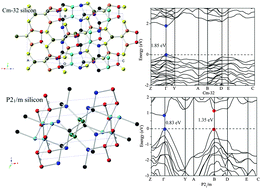Two novel silicon phases with direct band gaps
Abstract
Due to its abundance, silicon is the preferred solar-cell material despite the fact that many silicon allotropes have indirect band gaps. Elemental silicon has a large impact on the economy of the modern world and is of fundamental importance in the technological field, particularly in the solar cell industry. Looking for direct band gap silicon is still an important field in material science. Based on density function theory with the ultrasoft pseudopotential scheme in the frame of the local density approximation and the generalized gradient approximation, we have systematically studied the structural stability, absorption spectra, electronic, optical and mechanical properties and minimum thermal conductivity of two novel silicon phases, Cm-32 silicon and P21/m silicon. These are both thermally, dynamically and mechanically stable. The absorption spectra of Cm-32 silicon and P21/m silicon exhibit significant overlap with the solar spectrum and thus, excellent photovoltaic efficiency with great improvements over Fd![[3 with combining macron]](https://www.rsc.org/images/entities/char_0033_0304.gif) m Si. These two novel Si structures with direct band gaps could be applied in single p–n junction thin-film solar cells or tandem photovoltaic devices.
m Si. These two novel Si structures with direct band gaps could be applied in single p–n junction thin-film solar cells or tandem photovoltaic devices.


 Please wait while we load your content...
Please wait while we load your content...